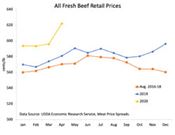Pandemic Effects Showing In Price Spreads In Meat Supply Chain
FAYETTEVILLE, ARK.
The meat sector is feeling an accordion effect. Squeezed by panic buying and supply chain disruptions, record gaps are forming between pricing at the farm and wholesale levels, according to an analysis done by John Anderson, economist for the University of Arkansas System Division of Agriculture.
Anderson is head of the agricultural economics and agribusiness department, with a joint appointment in the Dale Bumpers College of Agriculture, Food and Life Sciences. His analysis is based on data from the U.S. Department of Agriculture’s Economic Research Service.
He said the effects of April’s meat processing disruptions are apparent in the ERS data on the difference between the wholesale value of meat versus its farm-level net value. The loss in processing meant cattle intended for slaughter were beginning to back up on the farms.
“ERS reports an April farm-to-wholesale price spread of 165.1 cents/pound – or about 41 percent of a carcass’ wholesale value of 402 cents/pound,” Anderson said. “That is a record wide spread between farm and wholesale values and clearly demonstrates the unprecedented market consequences of the sharp loss in slaughter/processing capacity in the sector in April.”
Pork also saw increases, but they were not as dramatic as they were in beef.
“The farm-to-wholesale spread in pork also increased modestly in April to 59.9 cents/pound, or 49 percent of the wholesale value of 121.6 cents/pound,” Anderson said. “This is a relatively wide spread seasonally, but it is not unprecedented.”
Picking poultry
Poultry moved upward at the retail level, but not as much as might be expected given the disruptions in processing.
“Supply only describes one side of the market,” he said.
“It is a bit surprising that the biggest month-over-month percentage increase in retail price was observed in chicken,” which rose 5 percent from the previous month, Anderson said. “With falling consumer incomes and heightened perceptions of risk, consumers are likely favoring lower-priced product.
“With most food being prepared and consumed at home now, the greater availability of ready-to-eat and/or convenience products from chicken may also be influencing consumer demand,” he said.
To read more of Anderson’s analysis on COVID and consumer spending, see this and other economic impact reports at https://bit.ly/AR-Ag-Eco-Impacts2020. ∆

Analysis from the University of Arkansas System Division of Agriculture indicates that the effects of April’s meat processing disruptions are
apparent in USDA data on the difference between the wholesale value of meat versus its farm-level net value. The loss in processing meant
cattle intended for slaughter were beginning to back up on the farms.